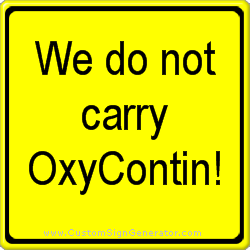“We Do Not Stock OxyContin” — signs like this are showing up in the windows of more and more pharmacies as robbers seeking the highly addictive painkiller become more brazen. The New York Times recently reported on a pharmacist in Maine who stopped filling prescriptions for OxyContin

following a robbery by two men wearing ski masks and wielding knives. The robbers were seeking only one thing — OxyContin. Rather than hiring a security guard, pharmacist Chet Hibbard decided to stop dispensing the drug and to post signs letting potential thieves know that they wouldn’t find OxyContin in his store.
Since its introduction in 1996, OxyContin has become the best-selling narcotic pain medication in the U.S. Its time-release formula has allowed many people who suffer from chronic pain to live more active lives. Unfortunately, OxyContin has also become one of the most highly abused prescription medications. Almost as soon as OxyContin appeared on the market, abusers began using forged prescriptions and other types of fraud to obtain the addictive painkiller. Now the incidence of robberies that target OxyContin is increasing, making pharmacies the new battleground in the war against drug abuse.
In the past three years, more than 1,800 robberies across the U.S. have targeted pharmacies. The thieves are usually young men in search of opioid painkillers and other prescription drugs. In addition to oxycodone (the drug found in OxyContin), thieves also seek hydrocodone (found in Vicodin) and benzodiazepine (found in Xanax). The violent robberies that are now taking place show the desperation of many prescription drug abusers. A robbery in Maine involved a man with a machete, while in Florida a robber use a cordless drill as a weapon.
In September of 2010, a shootout at a Rexall pharmacy in North Highlands, California (near Sacramento) left one employee dead and another wounded. Two men had entered the pharmacy and demanded drugs. When a male employee pulled out a semi-automatic handgun, a gun battle ensued. The would-be robbers escaped after shooting two female employees of the store.
Pharmacies that have decided to continue selling OxyContin and other addictive prescription drugs are upgrading their security and surveillance systems and putting their drugs behind bulletproof glass. Purdue Pharma, the manufacturer of OxyContin, is offering free training to help pharmacists avoid robberies. They are also providing training for police officers who investigate pharmacy robberies.
In 2007, Purdue Pharma agreed to pay fines totaling over $600 million that resulted from criminal charges that company executives misled the public about the potential for OxyContin addiction. When OxyContin was introduced, the company stated that its time-release formula decreased the threat of abuse and addiction. OxyContin was aggressively marketed as less addictive than fast-acting painkillers like Vicodin and Percocet. In reality, it was the time-release formula that allowed abusers to ground up the OxyContin pills and experience a heroin-like high.

